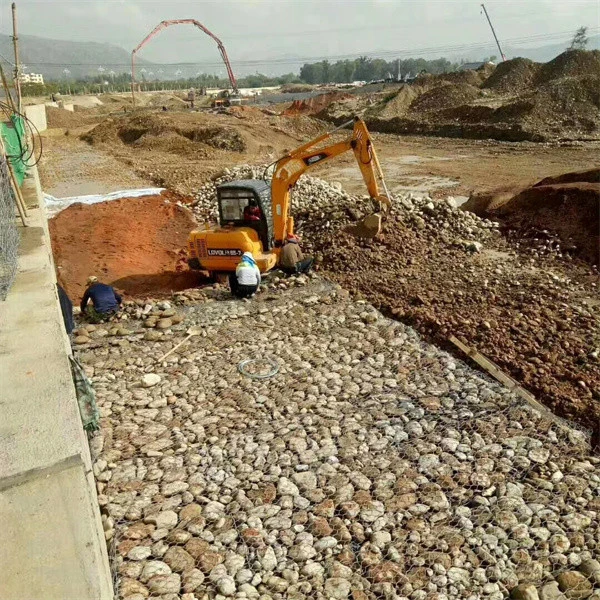Nov . 10, 2024 05:27 Back to list
Gabion Wall Solutions for Erosion Control on Sloped Terrains in Industrial Applications
The Benefits and Applications of Gabion Walls on Slopes
In the field of civil engineering and landscaping, the use of gabion walls has gained significant traction, particularly when addressing slope management and erosion control. Gabion walls, constructed from wire mesh cages filled with rocks or other materials, offer a robust solution to support and stabilize slopes while providing aesthetic appeal to a variety of environments. This article explores the various advantages, applications, and design considerations for gabion walls on slopes, highlighting their importance in modern engineering practices.
Understanding Gabion Walls
Gabion walls consist of wire mesh baskets filled with stones, concrete, or other durable materials. These structures are primarily designed to retain soil and provide stability on slopes, especially in areas prone to erosion. The flexibility of gabion walls allows them to adapt to various topographies and soil conditions, making them an ideal choice for projects requiring slope reinforcement.
Advantages of Gabion Walls
1. Erosion Control One of the primary functions of gabion walls is to prevent soil erosion. The porous nature of gabions allows water to flow through while trapping soil particles, effectively reducing the risk of landslides and maintaining the integrity of the slope.
2. Stability Gabion walls provide excellent lateral support to slopes, counteracting the forces of gravity and water. When built correctly, they can significantly decrease the chances of slope failure and soil movement.
3. Durability and Longevity Gabion walls are designed to withstand harsh environmental conditions. The materials used, such as galvanized steel or stainless steel mesh, resist corrosion, while the stones within make them robust against weathering and other forms of damage.
4. Cost-Effectiveness Compared to traditional retaining walls or concrete structures, gabion walls can be more affordable, particularly in remote areas where materials can be sourced locally. Additionally, their installation often requires less specialized labor and machinery.
5. Environmental Aesthetics Gabion walls can be aesthetically pleasing, especially when natural stones are used. They blend seamlessly into the landscape and can be planted with vegetation, promoting biodiversity and enhancing local ecosystems.
6. Easy Installation Gabion walls are relatively straightforward to install. Unlike concrete walls, which require extensive formwork and curing, gabion walls can be assembled on-site quickly, reducing construction time and costs.
Applications of Gabion Walls
Gabion walls are versatile and can be applied in various settings
gabion wall on a slope factory

- Civil Engineering Projects Used extensively in highways, railways, and embankment stabilization, gabion walls serve as effective supports and barriers against erosion.
.
- Landscaping In gardens and parks, gabion walls can act as decorative features, providing seating areas or retaining flower beds, while also serving the functional purpose of soil retention.
- Coastal Protection Gabion walls help protect coastlines from erosion due to waves and currents, creating resilient barriers that can withstand tough marine conditions.
- Terracing In agricultural settings, gabions can be used to create terraces, preventing soil erosion and improving water retention in hilly terrains.
Design Considerations
When designing gabion walls for slopes, engineers must take several factors into account
- Slope Angle The angle of the slope directly impacts the design and height of the gabion wall. Steeper slopes may require taller or more extensively structured walls.
- Drainage Proper drainage solutions should be integrated into the design to minimize water pressure against the wall, which could compromise its stability.
- Material Selection The choice of stones and mesh material is crucial for ensuring durability and effectiveness. Rocks should be durable and well-graded to minimize voids, while the mesh should be resistant to corrosion and structural stress.
- Local Regulations Engineering practices should comply with local geological regulations and environmental considerations to ensure safety and sustainability.
Conclusion
Gabion walls present a practical and versatile solution for slope stabilization and erosion control. With their numerous advantages, including durability, cost-effectiveness, and aesthetic appeal, these structures have become indispensable in various fields, from civil engineering to landscaping. As engineers and architects continue to explore innovative ways to utilize gabion technology, its applications will likely expand, enhancing our ability to manage and protect vulnerable landscapes effectively.
-
The Role of Galvanized Gabion Mesh in Riverbank Protection
NewsJun.26,2025
-
The Role of Gabion Basket Raised Bed in Sustainable Gardening
NewsJun.26,2025
-
Quality Assurance of Wire Mesh Gabion Baskets
NewsJun.26,2025
-
Installation Guide for Welded Gabion Box
NewsJun.26,2025
-
How to Choose the Right Gabion Box
NewsJun.26,2025
-
Different Types of Gabion Wire Mesh
NewsJun.26,2025
-
Why PVC Coated Gabion Mattress Is the Best Solution for Long-Term Erosion Control
NewsMay.23,2025






